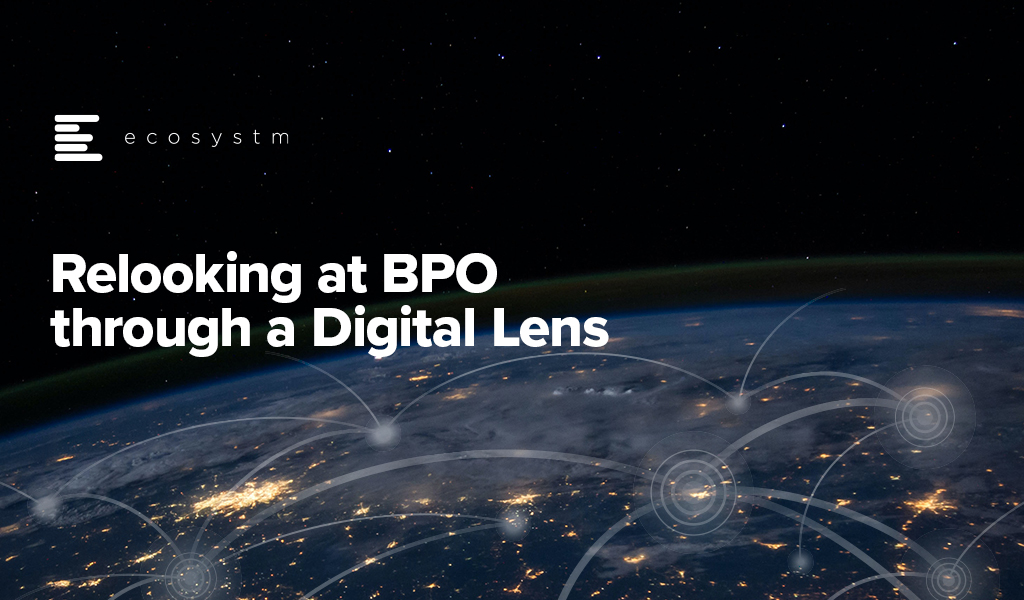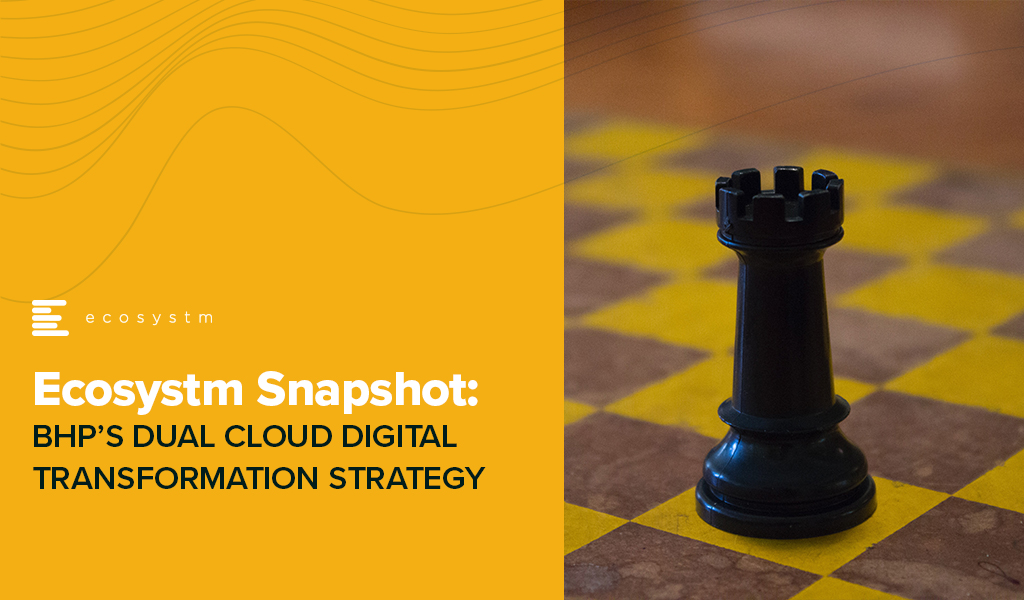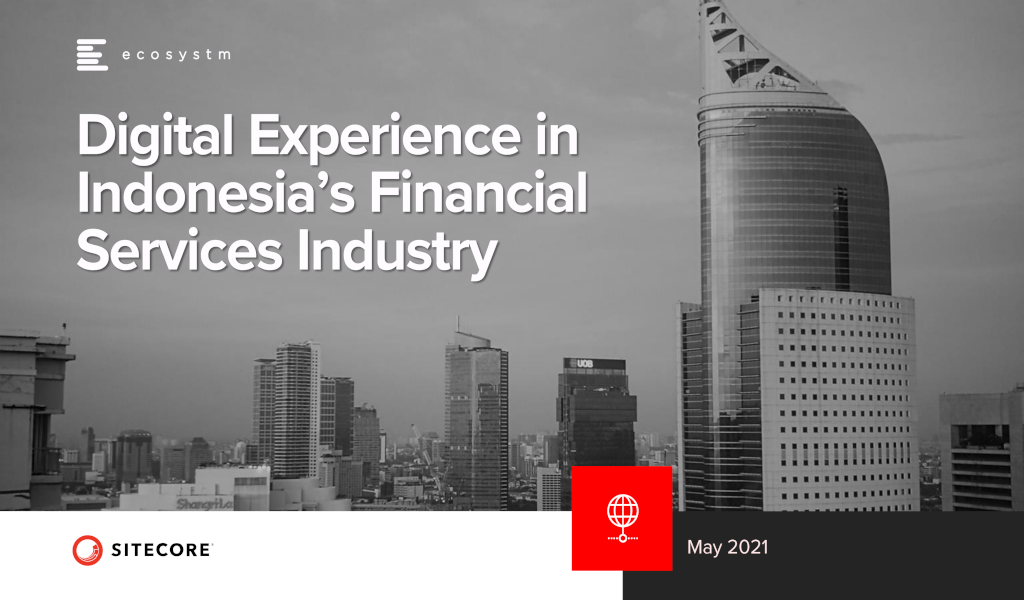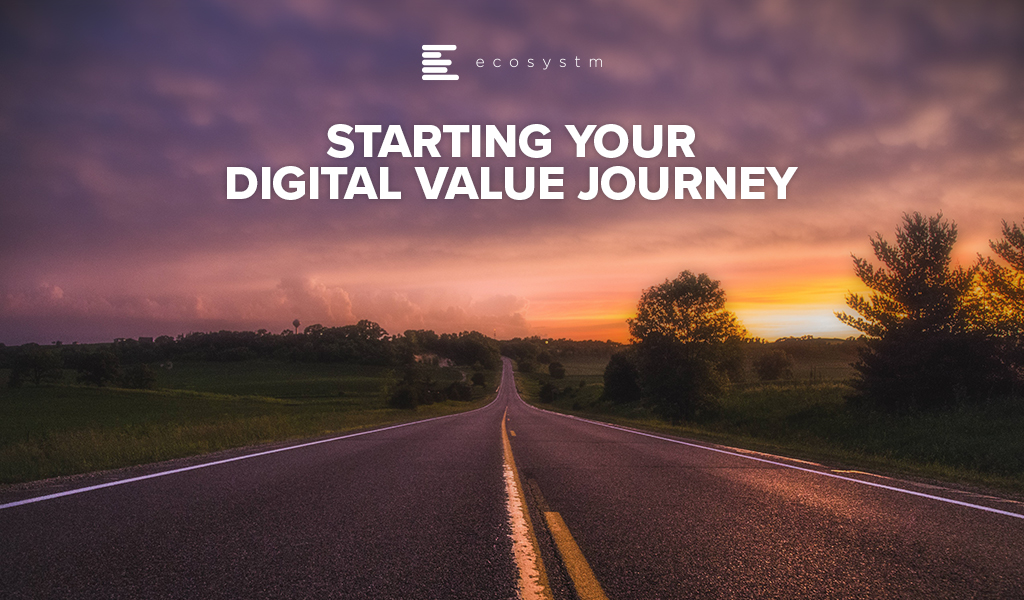When the FinTech revolution started, traditional banking felt the heat of competition from the ‘new kid on the block’. FinTechs promised (and often delivered) fast turnarounds and personalised services. Banks were forced to look at their operations through the lens of customer experience, constantly re-evaluating risk exposures to compete with FinTechs.
But traditional banks are giving their ‘neo-competitors’ a run for their money. Many have transformed their core banking for operational efficiency. They have also taken lessons from FinTechs and are actively working on their customer engagements. This Ecosystm Snapshot looks at how banks (such as Standard Chartered Bank, ANZ Bank, Westpac, Commonwealth Bank of Australia, Timo, and Welcome Bank) are investing in tech-led transformation and the ways tech vendors (such as IBM, Temenos, Mambu, TCS and Wipro) are empowering them.
To download this Ecosystm Bytes as a pdf for easier sharing and to access the hyperlinks, please click here.

COVID-19 has been a major disruption for people-intensive industries and the BPO sector is no exception. However, some of the forward-looking BPO organisations are using this disruption as an opportunity to re-evaluate how they do business and how they can make themselves resilient and future-proof. In many of these conversations, technology and process reengineering are emerging as the two common vectors in their journey to transform into a “New Age BPO” company.
Ecosystm research finds that running large, people-intensive centres can have a diverse range of challenges (Figure 1).

The transformation must address the top three pain points that have been plaguing the BPO industry:
- Staff scheduling and growing cost due to resource shortage in metro cities
- Managing physical and IT security with data security and industry best practices in mind
- Work/performance metrics that drive cost pressure and minimise differentiation
The New Age BPO
The wave of movement of the BPO centres away from expensive metro locations to tier 2 and tier 3 towns will now become even more significant – across all countries. This will enable BPOs to tap into a larger resources pool and at a much lower cost to the business. This will mean investments in process re-engineering and technology. But, before this journey starts, it is very important for these organisations to reimagine themselves in the context of value and differentiation – and it can no longer just be “I can do it faster and cheaper”!
Becoming a New Age BPO will mean replacing the traditional mindset of ferrying a large number of employees to the office around 24-hour shifts, by technology-enabled processes. Technology will enable these organisations to be a lot more agile, put the same (or better) safeguards on data and privacy, and drive better work efficiency.
For this transformation to happen, it is important for the BPO organisation to not just bounce back to what they have been used to, but should show a willingness to “bounce forward”, as my colleague Tim Sheedy puts it. This means that they take this disruption as an opportunity to relook at their staffing plans, business processes, and customer engagement – and leverage the right technologies to address areas of improvement in all three fronts. At the same time, technology adoption should not be done in silos. The comprehensive technology adoption plan must be designed to address all three areas (staffing, process, and customer engagement) simultaneously. The technology should also be architected to be scalable (by geography and staff levels) and allow better manageability in terms of real-time reporting and work allocation.
It will be a fine balance. But the good news is that the technology is not only available to address these areas but is also mature enough to be cost-effective. Of course, this will require the organisation to view technology as a strategic investment.
Another aspect of technology-led transformation that will benefit BPO organisations is the transparency that technology can provide and the opportunity to build better trust. This will be driven by full visibility of what is actually happening and the ability to provide real-time progress reports on issues raised. This means that quarterly site visits by clients to “show and tell” can be avoided. The discussions can be about specific points of interest and improvement rather than the “feel good factors” that these visits usually provide.
So, in many ways COVID-19 has accelerated the evolution of the “New Age BPO sector” and the intersection of this wave with the digital transformation wave will have a positive long-term impact on the BPO sectors in popular destinations such as India, the Philippines, Brazil, Mexico and others across the world.
Without this transformation, BPO organisations will keep pushing themselves into a tight corner and eventually be replaced by nimble and technology-savvy competitors that are focused on process and industry differentiation.

As the world has had to cope with a scenario never seen before in modern times, technology has been at the forefront of the response. This means hardware – computers, servers and the like – flew off the shelves. Cloud infrastructure and migration have been top of mind. “Digital Transformation” and the adoption of digital tools is expanding like a house on fire! We found that over 3 in 4 companies accelerated their digital plans in some way. Another 20% put plans on hold, largely because they felt the need to evaluate the old plans which became inadequate.
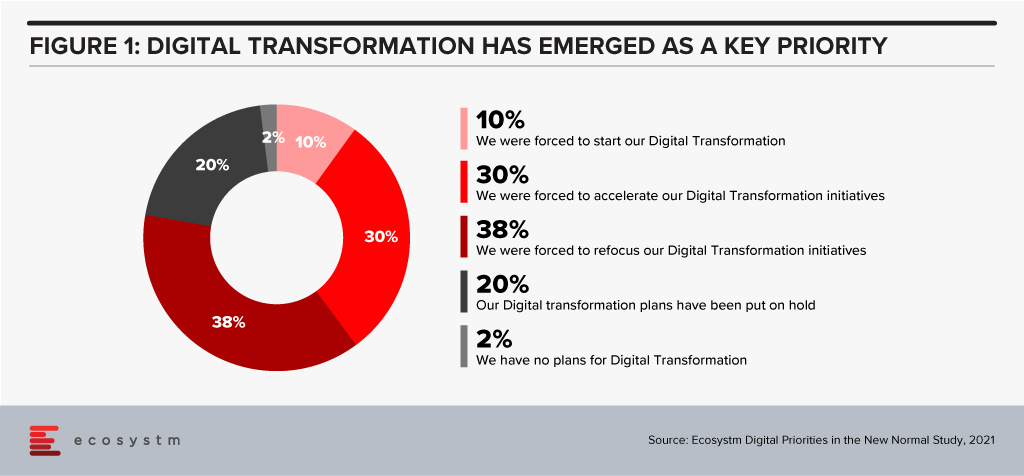
As vendors, channel partners and organisations scramble to put their new digital houses together and build the best digital castles possible, there is a major talent crunch. There are few who can deeply understand customer needs and recommend the right solution. While this affects all parties, the channel partners are feeling this more acutely. In my recent conversations with channel partners, it became evident that they are facing difficulties in finding and retaining good Sales and Solutions talent. There have also been complaints about talent being poached by the tech vendors they partner with!
The standard response to this problem is vendor certification and training. However, this is inadequate, due to three main reasons.
The Pace of Technological Change
The latest technology and what is possible with it changes on almost a daily basis. In this environment, for a person to keep up with everything is almost impossible. The ways in which a specific technology can be applied and the solutions it can deliver change, based on the ecosystem that forms around the technology and with the improvements in capability with time.
Small changes in different applications can cascade to create a solution (in terms of meeting a user need) which was not possible a short time ago. This may then compete with a completely different technology that has been considered satisfactory till date for the same user need. If the new option performs better, the old option is gone before you can snap your fingers.
For a salesperson to be across all this requires a solid understanding of the industry and its environment at a conceptual level. Given the pace of change, such people have become increasingly rare. They can be trained on a specific technology, not on perspectives, conceptual clarity or industry depth – that would require a formal degree!
The Limits of Lecture Style Training

Unfortunately, there is a key shortcoming in the whole certification program. A person going through any kind of classroom type training is limited in how much they can understand. This includes any kind of knowledge download or dump – videos, online courses, virtual classrooms, reading, webinars or physical classes. With technology that changes every day, the depth of knowledge imparted through such knowledge downloads is woefully inadequate. Expertise in technology is difficult to attain without getting one’s hands dirty.
Trying to make the training more “practical”, involving more exercises is good and does lead to better-trained personnel. But this is a long process and does not fit in with the timelines of most certification programs.
An actual customer implementation is probably the best teacher available right now. However, this leads to an unintended consequence – channel partners tend to stick with the vendor solutions that they have implemented before. Even if they can partner with other tech providers for better options they prefer to stick to what they know.
Vendor Bias in Training Programs
Certification is done, quite understandably, from the vendor’s point of view. The program is not built to generate an understanding of the tech world that we live in. That is taken as a given. Expertise in the vendor’s solution is the focus, and rightfully so. Talking points refer to that solution’s strengths and gloss over the weaknesses. There is no reason for a vendor to teach the participant the advantages of the competitor’s technology. Or explain the shortcomings of their own.
When the certified salesperson, however, is in front of the customer, this certification does not help them address all the queries. They are unable to clear the doubts or provide a complete (and objective) view that would satisfy a probing customer.
But there are ways in which this skills gap can be bridged – it will require both vendors and their channel partners to change how they view and grow talent. Stay tuned for the next feature where I share how the tech talent landscape can be changed.

BHP – the multinational mining giant – has signed agreements with AWS and Microsoft Azure as their long-term cloud providers to support their digital transformation journey. This move is expected to accelerate BHP’s cloud journey, helping them deploy and scale their digital operations to the workforce quickly while reducing the need for on-premises infrastructure.
Ecosystm research has consistently shown that many large organisations are using the learnings from how the COVID-19 pandemic impacted their business to re-evaluate their Digital Transformation strategy – leveraging next generation cloud, machine learning and data analytics capabilities.
BHP’s Dual Cloud Strategy
BHP is set to use AWS’s analytics, machine learning, storage and compute platform to deploy digital services and improve operational performance. They will also launch an AWS Cloud Academy Program to train and upskill their employees on AWS cloud skills – joining other Australian companies supporting their digital workforce by forming cloud guilds such as National Australia Bank, Telstra and Kmart Group.
Meanwhile, BHP will use Microsoft’s Azure cloud platform to host their global applications portfolio including SAP S/4 HANA environment. This is expected to enable BHP to reduce their reliance on regional data centres and leverage Microsoft’s cloud environment, licenses and SAP applications. The deal extends their existing relationship with Microsoft where BHP is using Office 365, Dynamics 365 and HoloLens 2 platforms to support their productivity and remote operations.
Ecosystm principal Advisor, Alan Hesketh says, “This dual sourcing is likely to achieve cost benefits for BHP from a competitive negotiation stand-point, and positions BHP well to negotiate further improvements in the future. With their scale, BHP has negotiating power that most cloud service customers cannot achieve – although an effective competitive process is likely to offer tech buyers some improvements in pricing.”

Can this Strategy Work for You?
Hesketh thinks that the split between Microsoft for Operations and AWS for Analytics will provide some interesting challenges for BHP. “It is likely that high volumes of data will need to be moved between the two platforms, particularly from Operations to Analytics and AI. The trend is to run time-critical analytics directly from the operational systems using the power of in-memory databases and the scalable cloud platform.”
“As BHP states, using the cloud reduces the need to put hardware on-premises, and allows the faster deployment of digital innovations from these cloud platforms. While achieving technical and cost improvements in their Operations and Analytics domains, it may compromise the user experience (UX). The UX delivered by the two clouds is quite different – so delivering an integrated experience is likely to require an additional layer that is capable of delivering a consistent UX. BHP already has a strong network infrastructure in place, so they are likely to achieve this within their existing platforms. If there is a need to build this UX layer, it is likely to reduce the speed of deployment that BHP is targeting with the dual cloud procurement approach.”
Many businesses that have previously preferred a single cloud vendor will find that they will increasingly evaluate multiple cloud environments, in the future. The adoption of modern development environments and architectures such as containers, microservices, open-source, and DevOps will help them run their applications and processes on the most suitable cloud option.
While this strategy may well work for BHP, Hesketh adds, “Tech buyers considering a hybrid approach to cloud deployment need to have robust enterprise and technology architectures in place to make sure the users get the experience they need to support their roles.”

In this Insight, our guest author Anupam Verma talks about how the Global Capability Centres (GCCs) in India are poised to become Global Transformation Centres. “In the post-COVID world, industry boundaries are blurring, and business models are being transformed for the digital age. While traditional functions of GCCs will continue to be providing efficiencies, GCCs will be ‘Digital Transformation Centres’ for global businesses.”

India has a lot to offer to the world of technology and transformation. Attracted by the talent pool, enabling policies, digital infrastructure, and competitive cost structure, MNCs have long embraced India as a preferred destination for Global Capability Centres (GCCs). It has been reported that India has more than 1,700 GCCs with an estimated global market share of over 50%.
GCCs employ around 1 million Indian professionals and has an immense impact on the economy, contributing an estimated USD 30 billion. US MNCs have the largest presence in the market and the dominating industries are BSFI, Engineering & Manufacturing, Tech & Consulting.
GCC capabilities have always been evolving
The journey began with MNCs setting up captives for cost optimisation & operational excellence. GCCs started handling operations (such as back-office and business support functions), IT support (such as app development and maintenance, remote IT infrastructure, and help desk) and customer service contact centres for the parent organisation.
In the second phase, MNCs started leveraging GCCs as centers of excellence (CoE). The focus then was product innovation, Engineering Design & R&D. BFSI and Professional Services firms started expanding the scope to cover research, underwriting, and consulting etc. Some global MNCs that have large GCCs in India are Apple, Microsoft, Google, Nissan, Ford, Qualcomm, Cisco, Wells Fargo, Bank of America, Barclays, Standard Chartered, and KPMG.
In the post-COVID world, industry boundaries are blurring, and business models are being transformed for the digital age. While traditional functions of GCCs will continue to be providing efficiencies, GCCs will be “Digital Transformation Centres” for global businesses.
The New Age GCC in the post-COVID world
On one hand, the pandemic broke through cultural barriers that had prevented remote operations and work. The world became remote everything! On the other hand, it accelerated digital adoption in organisations. Businesses are re-imagining customer experiences and fast-tracking digital transformation enabled by technology (Figure 1). High digital adoption and rising customer expectations will also be a big catalyst for change.

In last few years, India has seen a surge in talent pool in emerging technologies such as data analytics, experience design, AI/ML, robotic process automation, IoT, cloud, blockchain and cybersecurity. GCCs in India will leverage this talent pool and play a pivotal role in enabling digital transformation at a global scale. GCCs will have direct and significant impacts on global business performance and top line growth creating long-term stakeholder value – and not be only about cost optimisation.
GCCs in India will also play an important role in digitisation and automation of existing processes, risk management and fraud prevention using data analytics and managing new risks like cybersecurity.
More and more MNCs in traditional businesses will add GCCs in India over the next decade and the existing 1,700 plus GCCs will grow in scale and scope focussing on innovation. Shift of supply chains to India will also be supported by Engineering R & D Centres. GCCs passed the pandemic test with flying colours when an exceptionally large workforce transitioned to the Work from Home model. In a matter of weeks, the resilience, continuity, and efficiency of GCCs returned to pre-pandemic levels with a distributed and remote workforce.
A Final Take
Having said that, I believe the growth spurt in GCCs in India will come from new-age businesses. Consumer-facing platforms (eCommerce marketplaces, Healthtechs, Edtechs, and Fintechs) are creating digital native businesses. As of June 2021, there are more than 700 unicorns trying to solve different problems using technology and data. Currently, very few unicorns have GCCs in India (notable names being Uber, Grab, Gojek). However, this segment will be one of the biggest growth drivers.
Currently, only 10% of the GCCs in India are from Asia Pacific organisations. Some of the prominent names being Hitachi, Rakuten, Panasonic, Samsung, LG, and Foxconn. Asian MNCs have an opportunity to move fast and stay relevant. This segment is also expected to grow disproportionately.
New age GCCs in India have the potential to be the crown jewel for global MNCs. For India, this has a huge potential for job creation and development of Smart City ecosystems. In this decade, growth of GCCs will be one of the core pillars of India’s journey to a USD 5 trillion economy.
The views and opinions mentioned in the article are personal.
Anupam Verma is part of the Senior Leadership team at ICICI Bank and his responsibilities have included leading the Bank’s strategy in South East Asia to play a significant role in capturing Investment, NRI remittance, and trade flows between SEA and India.

Organisations are increasingly investing in digital. However, they are at different stages of their digital maturity. Some companies are in the early transitional stages while others are investing to upgrade capabilities they instituted long ago. An understanding of the digital maturity of a typical organisation in your market/industry can help you benchmark your technology and. digital roadmap.
This ebook presents some key findings for financial services within Indonesia. You will get insights on impact of COVID-19 on transformation journeys, key business priorities for 2021, and the shift in engagement strategies and channels.
Click below to download the eBook

(Clicking on this link will take you to Sitecore website where you can download the eBook)

Digital and IT organisations are going through some dramatic changes as they adopt cloud and as-a-service capabilities. In this post, I want to write about two of these – one that is very much a consequence of the other.
Contract Numbers are Exploding
We’re seeing an explosion in the number of IT suppliers to a typical organisation.
Pre-cloud, the typical organisation probably had five to ten contracts that covered most of the external services that were in use. With suppliers increasingly providing niche functionality and the increased use of credit cards to buy external services, it is often difficult to determine exactly how many contracts are in place. Or, indeed, have a clear understanding of the terms and conditions of each of these contracts.
Where once an organisation might have had contracts for an on-premises ERP and CRM system, a typical organisation will still have those contracts as well as a supply chain forecasting service, a marketing email management tool, not to mention online spreadsheets and task management capabilities.
So with many more contracts in place, the complexity of managing these contracts and understanding the technical, legal and business risks encapsulated in these contracts has become dramatically more difficult.
I’ll return to this point in a later post, as most organisations struggle with this increasing complexity.
What Is Happening to Your People?
The existence of these contracts means that you are increasingly becoming dependent on the people employed by these external organisations. But when you sign up for these contracts, do you investigate how these suppliers develop their talent?
The New Zealand Herald recently carried an interesting article on one organisation that has developed a paid intern program. Something very rare in the industry.
The article prompted me to think through some of the implications of using cloud services. Tech buyer organisations will have less need for technical capabilities as increasingly these are delivered by the cloud suppliers.
But the growth in demand for digital and IT skills just continues to increase as more and more industries digitalise. In the past, tech buyer organisations would have invested (at least the good employers did!) in the development of their people. The cloud suppliers are increasingly doing this talent development.
Most contract negotiations are based on cost, quality and customer service. A significant proportion of cloud contracts are now boilerplate – you pay with a credit card for a monthly service and have little or no ability to negotiate terms and conditions.
The trade-off is required to get a short commitment term and a variable cost profile. No tech vendor can afford to negotiate bespoke contracts for this type of commercial arrangement.
This situation leaves the question of how tech buyers can influence tech vendors to develop their people’s talent appropriately. Some would say that the tech vendors will do this as a matter of course, but the statistics, as highlighted in the Ecosystm research data in Figure 1, show that we are not bringing people in at the rate the industry requires.

Advice for Tech Buyers
I recommend you look closely at using two tactics with the tech vendors that you are working with:
- First, look to consolidate as much workload as practical under a single contract with the supplier. This is not a new recommendation for contracts – but with the increasing use of boilerplate contracts, it is one of the few ways an organisation can increase its value and importance to a tech vendor.
- Second, start finding those tech vendors that are developing new and existing talent in practical ways and favour these organisations in any purchase decision.
Most organisations, individually, do not have the commercial power to dictate terms to the cloud providers. Still, if enough tech buyers adopt this critical criterion, the cloud providers may see the value in investing in the industry’s talent development in meaningful ways.
The downside? Talent development does not come free. Tech buyers may need to pay a higher fee to encourage the suppliers but paying a low-cost provider who does not develop their talent sounds like a recipe for poor quality service.
If you would like to discuss any of these thoughts or issues further, please feel free to reach out and contact me. This is an industry issue and one for our broader society, so I would be interested in hearing how your organisations are addressing this challenge.

2020 was a strange year for retail. Businesses witnessed significant disruption to supply chains, significant swings in demand for products (toilet paper, puzzles, bikes etc!) and then sometimes incredible growth – as disposable income increased as many consumers are no longer taking expensive holidays. Overall, it was a mixed year, with many retailers closing down and others reporting record sales. The grocery sector boomed – with many restaurants and fast-food providers closed, sometimes the supermarkets were some of the few remaining open retailers.
For many retailers, technology has become a key enabler to their transformation, survival and success (Figure 1).
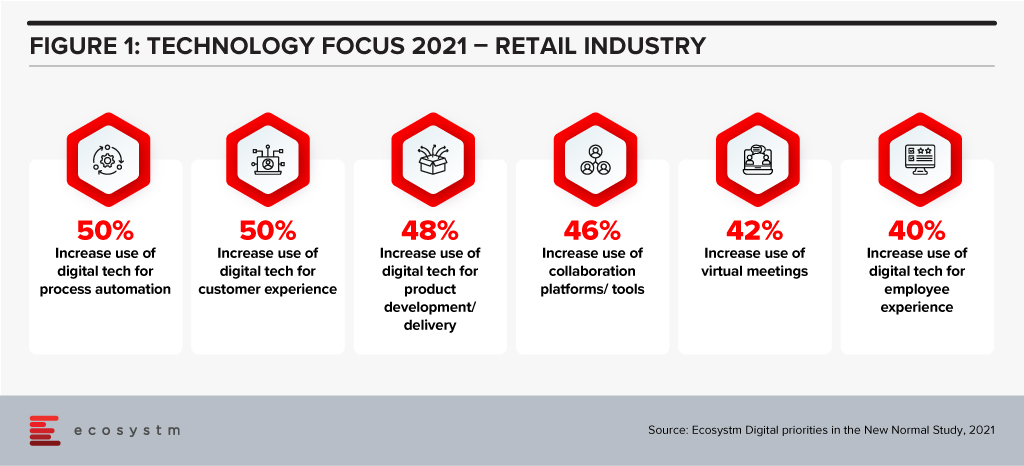
Woolworths, Australia’s largest retailer, operates across the grocery, department store, drinks, and hospitality sectors. They hold a significant market share in most markets that they operate in. The company had a strong 2019/20 (financial year runs from July 2019 to June 2020) with sales up 8% – and in the first half of the 2020/21 financial year, sales were up nearly 11%. But the company is not resting on its laurels – one of its 6 key priorities is to “Accelerate Digital, eCom and convenience for our increasingly connected customers”. This requires more than just a deep technology investment, but a new culture, new skills, and new ways of working.
Woolworths’ Employee Focus
Woolworths has committed to invest AUD 50 million in upskilling and reskilling their employees in areas such as digital, data analytics, machine learning and robotics over the next three years. The move comes as a response to the way the Retail industry has been disrupted and the need to futureproof to stay relevant and successful. The training will be provided through online platforms and through collaborations with key learning institutions.
The supermarket giant is one of Australia’s largest private employers with more than 200,000 employees. Under Woolworths’ ‘Future of Work Fund’ their staff will be trained across supply chain, store operations, and support functions to enhance delivery and decision-making processes. The retailer will also create an online learning platform that will be accessible by Woolworths employees as well as by other retail and service companies to support the ecosystem. Woolworths has plans to upskill their staff in customer service abilities, leadership skills and agile ways of working.
Woolworths’ upskilling program will also support employees who were impacted by Woolworths planned closures of Minchinbury, Yennora, and Mulgrave distribution centres due in 2025.
Woolworths’ Tech Focus
Woolworths has been ramping up their technology investments and having tech-savvy employees will be key to their future success. In October 2020, Woolworths deployed micro automation technology to revamp their eCommerce facility in Melbourne to speed up the fulfilment of online grocery orders, and front and back-end operations. Woolworths also partnered with Dell Technologies in November 2020 to bring together their private and public cloud onto a single platform to improve mission-critical processes, applications and support inventory management operations across its retail stores.
Future of Work
For many years, Ecosystm has been advising our clients to invest more in the skills of the business. Every business will be using more cloud next year than they are this year; they will suffer more cybersecurity incidents; they will use more AI and machine learning; they will automate more processes than are automated today. More of their customer engagements will be digital, and more insight will be required to drive better outcomes for customers and employees. This all needs new skills – or more people trained on skills that some in the business already understand. But too many businesses don’t train in advance – instead waiting for the need and paying external consultants or expensive new hires for their skills. Empowered businesses – ones that are creating a future-ready, agile business – invest in their people, work environment, business processes and technology to create an environment where innovation, transformation and business change are accepted and encouraged (Figure 2).
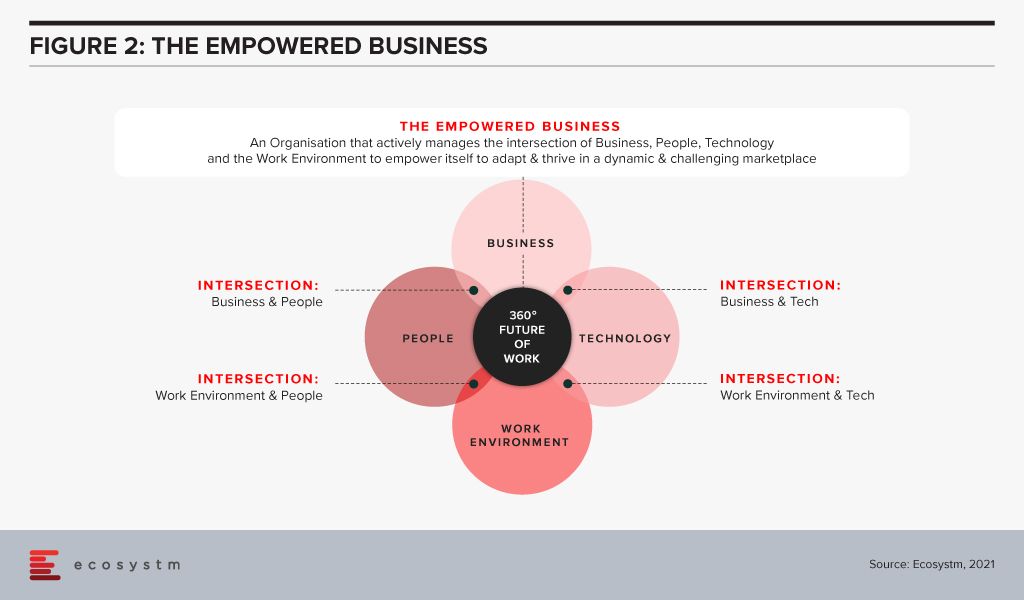
Empowered businesses can adapt to new challenges, new market conditions and respond to new competitive threats. By taking these steps to upskill and empower their employees, Woolworths is building towards empowering their own business for long term success.
Transform and be better prepared for future disruption, and the ever-changing competitive environment and customer, employee or partner demands in 2021. Download Ecosystm Predicts: The top 5 Future of Work Trends For 2021.

Over the next few months, we’re going to be focusing on the five stages of the Digital Value Journey and how an organisation and a leadership team can progress through these stages.
The Journey starts with baselining and then improving your execution capability.
Your Foundation
The quality of your execution needs to be consistently improved as you and your organisation make progress through your Journey. At the start, it is about developing the foundation on which you can build more complex and valuable business capabilities. You need that reliable, performing foundation that delivers what your customers and employees need every day.
For any Digital or IT organisation to succeed, it needs two critical things: a record of consistent success, and the trust from your organisation that past performance is a reliable predictor of the future.
Every day your customers and employees will be evaluating those two things. It’s like sitting a difficult exam every day. Failing one will be remembered – much more so than all the other exams that you successfully passed. To pass that exam you need to clearly understand what people are testing you on every day.
Understanding how the quality of your work will be evaluated is essential to creating and maintaining this firm foundation. Everything you do later in the Journey will depend on the foundation you establish at the start.
Evaluating your Foundation
And you don’t have the freedom to choose how that foundation is going to be evaluated. There is a universe – or perhaps that should be a multiverse – of metrics that you could use. Selecting the small set of metrics that your stakeholders believe demonstrate your performance is essential.
Too many metrics is just as bad as too few – you won’t know which ones to focus on so you will end up spreading yourself too thinly. Your stakeholders are the best people to tell you how to measure your performance. Work with them to determine the one or two indicators that they really care about.
Schools and universities have improved dramatically in explaining how they are going to evaluate a student’s performance since I attended! As part of almost every assignment, educators include an evaluation rubric to guide each student. This sets out what how the educator will assess the students work. So, getting great grades is dependent on understanding this rubric.
What is your rubric? Without one how will you know what outcomes your stakeholders value and how they will evaluate your work? Spending time to talk with your stakeholders about what they value, is a habit that is worth developing early and maintaining throughout the Journey.
Your Next Best Steps
Getting this execution foundation right is the basis for everything that follows.
In the first of a series of webinars on 22 April, we will be introducing the concepts and ideas that we will expand on over the series.
Getting a quality education is a long hard slog – and I can’t promise that starting this Digital Journey will be any different. At each stage of the Journey different levels of capability will be required, but, as with an education, these higher levels of capability will only be possible if the right foundation is in place. So, join us to see how you can use the Digital Value Journey to lift the performance of your organisation and its Digital or IT Team.
How do digital leaders shift from providing a cost-focused to a value-focused service? At the CXO Digital Leaders Dialogue series, together with Best Case Scenario, we will be in discussion with leaders who will share their experiences with navigating these challenges.
To learn more, or to register to attend, visit here














